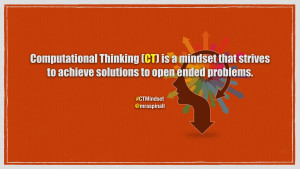The coding movement certainly has gained a great deal of traction in a very short period of time. When you consider Seymour Papert’s work in the 70s and 80s, the last three years of Hour of Code are only a small, but significant blip on the historical timeline of Computer Science integration as a compulsory credit in schools. There were many before me right here in Ontario trying to create a movement towards a constructivist approach to learning, and not just in mathematics.
When we consider the importance of coding and Computer Science education, let’s not forget the importance is learning.
Coding plays a minor role in Computer Science education. However, it has taken on the only label of what CS is about. Computer Science is about how things work and how we can make them work better, using coding and other hardware tangibles. The key is that we must think critically about how things work and think critically about how we can improve them. The key to Computer Science is thinking. I am not suggesting we don’t think in other disciplines, I want to raise an awareness to the importance of coding and Computer Science beyond the “future jobs” narrative. No one can argue the Internet of Things will create a multitude of programming jobs in the near future. But many students won’t be professional coders.
“Computational thinking will be in every aspect of our economy.” – Satya Nadella
Providing students with open ended opportunities to think critically (with or without coding) creates problem solvers and independence, both of which are required skills for today’s industry. Experts have branded a set of skills as “21 Century Competencies” which include computational thinking. Coding also supports spatial sense and makes students think about possible scenarios. Regardless of their chosen profession, thinking critically provides students with a variety of perspectives.
Great chess players can visualize multiple outcomes and react accordingly to different moves from their opponent.
Excellent point guards are able to view possible situations on the basketball court in a matter of seconds. Professional choreographers think in repeating patterns and can visualize a team of dancers through a wide lens.
So why should students be coding in schools? Well, that depends on the goal or task. If you want to create a community of risk-takers,problem solvers and independent thinkers, give coding a shot. Tinkering, making, remixing and disassembling old technology also provide students opportunities to think computationally. Computer Science education is much larger than just coding. Ultimately, don’t we want students to decide for themselves what their future profession will be? You don’t know if you like broccoli until you try it.










